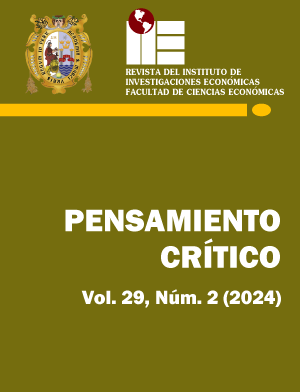Decomposition of multidimensional and monetary poverty into components of Growth and Income Distribution in Bolivia
DOI:
https://doi.org/10.15381/pc.v29i2.29474Keywords:
Poverty, Growth, Distribution, MultidimensionalAbstract
This article calculates the measures of multidimensional and monetary poverty and its sources of changes due to the effects of growth and income distribution in Bolivia, period 2015-2022. The methodology for calculating multidimensional poverty was developed by Alkire and Foster (2011) and for monetary poverty the poverty line method was used. The methodology for the decomposition of growth and distribution effects is based on Datt – Ravallion (1992).
The main results of the estimates are that monetary poverty in the period 2015-2019 was reduced from 38.6% to 37.2%. In the year of COVID 2020, poverty increased to 39%. The incidence of multidimensional poverty is high, going from 57.48% in 2015 to 44.76% in 2022, the intensity of multidimensional poverty is 45.41% in 2022. Multidimensional poverty is a worrying phenomenon among households that have more informal employment.
Poverty, during the period of economic slowdown (2015-2019) decreased by 1.4 points, determining the growth effect a decrease of 0.0447 and the distribution effect a decrease of 0.039475. In 2020, the growth and distribution effect increased poverty by 0.035368 and 0.0217412 respectively. Poverty in Bolivia is more sensitive to economic growth.
Downloads
Published
Issue
Section
License
Copyright (c) 2024 Ernesto Bernal Martinez, Erika Soliz Cuevas

This work is licensed under a Creative Commons Attribution 4.0 International License.
THE AUTHORS RETAIN THEIR RIGHTS:
a. The authors retain their trademark and patent rights, and also on any process or procedure described in the article.
b. The authors retain the right to share, copy, distribute, execute and publicly communicate the article published in Pensamiento Crítico (for example, place it in an institutional repository or publish it in a book), with recognition of its initial publication in Pensamiento Crítico.
c. The authors retain the right to make a subsequent publication of their work, to use the article or any part of it (for example: a compilation of their works, notes for conferences, thesis, or for a book), provided they indicate the source of publication (authors of the work, journal, volume, number and date).






